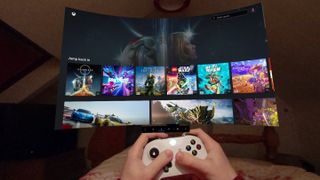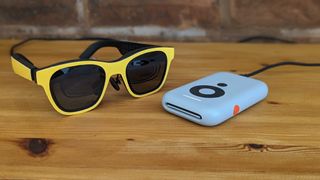The Meta Quest 3 doesn’t beat my 4K TV for Xbox gaming, but I don’t care – I love it
After Thursday's surprise Xbox Cloud Gaming launch on the Meta Quest 3, I've spent most (read: too many) evenings trying out the service. And while it doesn't technically come close to my more traditional 4K TV and console setup, the portability more than makes up for it.
For the uninitiated, Xbox Cloud Gaming is basically Netflix for video games. For a monthly fee of $16.99 / £12.99 / AU$18.95 you can stream titles from a huge catalog of content to your phone, PC, Xbox console and now Meta Quest 3, Quest 2 and Quest Pro . The advantage, of course, is that you don't need super-powerful hardware to play the latest games – they run on high-end machines many hundreds (maybe thousands) of miles away and simply use your device as a screen and relay for your controller inputs.
When you play in the real world, you are limited to the size of your TV, phone screen or computer monitor. In VR you can play these games on a giant virtual screen, with the size becoming especially apparent when you use Quest 3's mixed-reality mode. The large and extra-large screen options were bigger than any TV I've seen before – even the ridiculous ones seen at tech shows – and it made me feel like I was gaming in my own private cinema.
The disadvantage is that the graphic quality leaves much to be desired. Xbox Cloud Gaming can apparently stream 1080p (full-HD) with 60fps gameplay – but I'm sure the quality I experienced wasn't that high. That's most likely due to a combination of the Quest 3's display specs, my internet connection limiting the app's capabilities, and the gigantic virtual screen that leaves nowhere to hide visual imperfections; instead, we blow them up to make them more striking than ever.
Head in the cloud
But as I lay in bed with my Quest 3 on and the virtual display hovering above me on the ceiling using mixed reality, I was still completely lost in Starfield until the early hours. I only stopped when my headset alerted me that the battery was low and I realized it was well after 2am.
This portability – being able to play anywhere with a strong enough internet connection – is why cloud gaming in VR is successful. You can play in bed, while commuting, in a coffee shop while waiting for your friends, or just about anywhere you can think of. Yes, you can stream Xbox titles to your phone too, but the screen is small and the experience just isn't as immersive as the virtual screen that wraps around you.
To this end, the VR headset is starting to borrow elements from the many AR glasses I've tested over the past year – like the Xreal Air 2 or Rokid Max – and I'm pretty excited about it. These AR specs connect to a compatible phone, laptop or gaming console using a USB-C adapter and virtually project the screen for you.
The clear advantage of the Quest hardware is that it's more than just a portable projector: it's an entire spatial computer in itself that can do incredible things without any external hardware. Plus, the Quest 3 is more expensive on paper – around $100 / £100 / AU$150 depending on the goggle – once you factor in the need to buy a few not-so-optional add-ons to get the most out of the to get glasses. AR specifications, the cost difference is negligible (the Quest 3 could even become cheaper). Not to mention that you get a lot more bang for your buck with a VR headset.
While going completely wireless has its advantages, after trying Xbox Cloud Gaming I'm even more desperate for Meta's VR hardware to start supporting wired connections to a wider range of devices. I'd love to use a Steam Deck, Nintendo Switch, PS5, and other gadgets in a similarly immersive way without having to weigh in on AR specs. Hopefully, such features will be added to the Quest platform in the not-too-distant future.
Some work is needed
However, before Meta works on adding these capabilities, I would like to see Microsoft and Microsoft make a few updates to the Xbox Cloud Gaming app. Considering this app was announced over a year ago at Meta Connect 2022, I'm surprised it's so basic and lacks a few features that feel like no-brainers.
The first is an easy way to position the screen. As far as I can tell, the only virtual display controls within the app are the size options. If you want to move the screen to a different position – which is essential when playing landscape – you'll first need to press the Oculus button to open your quick menu bar. Then, when you grab the bar to move it, the Xbox screen moves with it.
This solution is effective but not intuitive; I got into it completely by accident.
The second is an emulator, so the Quest handsets can act as an Xbox controller. Admittedly, this can be tricky, as the controllers are virtually identical, but the Quest controllers lack the D-Pad and third menu button. Even if this emulated controller is only compatible with a small selection of titles, it would give users a great way to try out Cloud Gaming before investing in a wireless Xbox controller (they're not hugely expensive, but they're not cheap either – they're more expensive than most VR games).
Finally, it would be helpful if there was a way in the app to see how stable your connection is, what resolution and framerate you're getting, and choose whether to optimize for graphics or performance.
That said, despite its shortcomings, the Xbox Cloud Gaming app is a must-try – especially for those who already have an Xbox Game Pass Ultimate subscription and a compatible controller. While I will still spend a lot of time gaming on my TV, I honestly see this VR app becoming one of my most used apps in 2024. It might even convince me to take my Quest 3 with me everywhere so I can game on the go.


